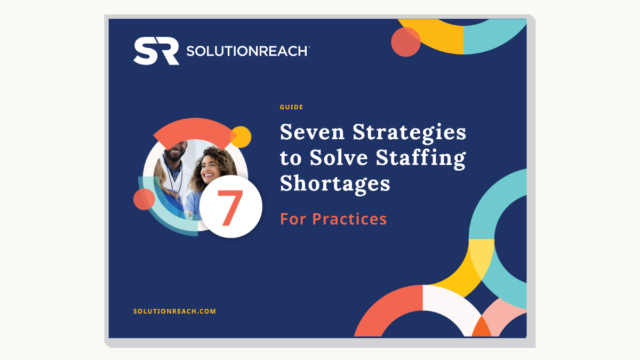It’s no coincidence that healthcare practices and clinicians often refer to the patient experience as a “journey.” It’s not just fancy marketing jargon but accurately describes the patient care delivery for most medical conditions as a “process” which requires ongoing treatment, management, and outreach.
For that reason, your patients’ care also includes a series of critical patient-provider interactions—or patient follow-ups—to ensure patients and caregivers adhere to provider instructions and care steps. Preventive care requires continual maintenance and vigilance as does managing long-term or chronic conditions so patients avoid gaps in care and poorer outcomes.
In this article, we’ll look at why patient follow-up is important, different options for follow-up, and how to create a follow-up strategy that stresses effectiveness, promotes efficiency, and minimizes manual staff workload.
What are the reasons for patient follow-up? Why is it important?
There are any number of critical reasons to reach out to patients following an appointment or in between appointments as a baseline:
- Monitor patients’ symptoms
- Reinforce care knowledge and action plans
- Provide relevant patient education
- Confirm medicine regimens
- Schedule follow-up visits
- Verify follow-through on referrals
- Share lab test results
- Get patients back in for ongoing preventive care and chronic disease management
In every scenario, follow-up is crucial to moving the care process forward, monitoring patients’ symptoms and level of improvement, and confirming that patients adhere to care instructions needed to attain better outcomes. Follow-up is a key component of “the continuum of care,” in which practices follow a patient from preventive care, through medical incidents, rehabilitation, and maintenance. The gist here is that coordinated, collaborative, and unbroken efforts to provide care lead to better health for patients and higher patient satisfaction.
Through your carefully coordinated follow-up interactions with patients, you’re able to achieve the following:
- Maintain positive outcomes
- Reduce hospital readmissions
- Foster stronger relationships with your patients
- Gain operational efficiencies
How do I structure a productive and workable follow-up plan?
First things first, you’ve got to determine which specific types of patient encounters and conditions need patient follow-up and what form that follow-up should take. You’ll need to use different means of follow-up for various appointment types and diagnoses and set up reminders for the timing of your follow-up. While not an exhaustive list, these are some of the many variables you’ll need to consider:
- Who will follow up with patients?
Providers, nurses, admin staff, etc., may vary depending on whether the follow-up is clinical or administrative. If the follow-up is complex or sensitive in nature, you may opt to have a provider contact the patient.
- What method of follow-up will you use?
Text message, email, automated calling system, postal mail, or patient portal? For follow-up to be most effective at actually reaching the patient, you’ll want to match your follow-up method to individual patient communication preferences and language. You’ll also want to ensure that your follow-up method for each specific follow-up is HIPAA compliant.
- Determine the most appropriate schedule and time frame for follow-up.
It may be 24 to 48 hours after an appointment, three days, a week or whatever time frame you deem appropriate for the patient case you’re following up on.
- How will your follow-up be monitored and tracked?
Will you use an EHR, a PM, or a patient communications platform? Make sure you identify which staff members will be updating these tracking systems. With a patient communications tool, you can automatically follow up with patients by text, email, or voicemail.
How can I streamline and efficiently manage patient follow-up without placing a heavy burden on my front office staff?
You couldn’t possibly find enough time in the day to manually follow up with every patient and still run your office smoothly. That’s why the key to not overwhelming your admin staff with patient follow-up activities is to lean on technology like patient communications tools which lighten their workload.
These tools provide you with the automation, personalization, and customization to reliably and efficiently follow up with every patient while minimizing monotonous manual tasks such as making phone calls and composing emails from scratch. Instead of working harder, leverage software solutions to work smarter. Consider the following examples:
- Provide patients with a copy of the doctor’s care instructions after the visit: Because patients forget 40%–80% of the care instructions a doctor and/or care team gives them during the appointment, use a patient messaging tool to follow up with them. Automatically text or email patients a copy of the doctor’s care instructions after the appointment to increase adherence, re-emphasize the care plan, and help patients achieve better outcomes.
- Help patients remember to schedule appointments for follow-up care: Patients are often overwhelmed with information and instructions during office visits. Make it easy for them to book follow-up appointments by sending them a reminder via text/email/voice. If the reminder is sent as a text or email, you can also include a secure link for them to click to access your online scheduling tool. This saves them the hassle of having to call in and allows them to instantly select a day and time for their next visit.
- Share valuable patient education with patients on specific health topics: Better educated patients make better decisions about their health and help them more closely adhere to their care plans. For example, to help your diabetes patients better adhere to their diets, medications, glucose monitoring, and care plans, use a patient education newsletter tool to send them relevant articles about managing their Type I or Type II diabetes or potential side effects from new prescriptions. Narrow the email address list by selecting send criteria as only patients with a diabetes diagnosis.
- Leverage technology to extend your reach and overcome patient barriers to access care: For many types of follow-up, you may not necessarily need to physically have the patient in your exam room, dentist’s chair, or optometrist’s chair. For many types of routine follow-up or post-procedure check-ins, a live video call conducted via a telehealth tool may be exactly what the doctor ordered. If patients have to travel great distances to reach your office or if transportation or other access barriers to care exist, telehealth can be an attractive and beneficial alternative for patient follow-up. You can check up on a patient’s progress or symptoms while they can receive care from the comfort of their armchair.
- Minimize ineffective hours spent recalling patients by phone with a more productive approach: Recall more of your patients more efficiently by getting your staff off the phones with a recall notification tool. Automatically send overdue patients text reminders to schedule a visit for a dental hygiene visit, annual eye exam, or preventive screening. Even more efficient, use a batch messaging tool to recall patients by a variety of selection criteria such as age, sex, diagnosis, or date of last appointment.
- Give your patients the ability to ask questions, clarify a care instruction, or reschedule anytime, anywhere without calling: Patients get your texts and they want to be able to send texts to your office instead of calling in. Ensure patients needing to follow up with you can instantly reach you with a text via real-time, two-way texting to your main practice phone number. This ability frees up your staff from frequent call interruptions and allows them to easily reply to patient texts in between other tasks.
Key Takeaways
By carefully crafting a protocol for patient follow-up interactions, you’ll be able to more effectively reach out to patients after their appointment and more reliably and successfully guide them along the care journey. Applying best practices and patient communications tools will give you the speed and efficiency to follow up with large numbers of patients without creating an unmanageable burden for your front office staff.
More consistent and meaningful follow-up procedures and workflows will allow your practice to better support your patients in a continuum of care, avoid gaps in care, lead to better educated patients, and help them stick to their care plans and arrive at better patient outcomes.

To learn more about how to run a more efficient and productive front office in light of staff shortages, download the guide, “Seven Strategies to Solve Staffing Shortages.”
Read the Guide



